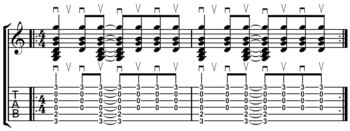Strum



In music, strumming is a way of playing a stringed instrument such as a guitar. A strum or stroke is a sweeping action where a fingernail or plectrum brushes past several strings in order to set them all into motion and thereby play a chord. Strums are executed by the dominant hand, while the other hand holds down notes on the fretboard. Strums are contrasted with plucking, as a means of activating strings into audible vibration, because in plucking, only one string is activated by a surface at a time. A hand-held pick or plectrum can only be used to pluck one string at a time, but multiple strings can be strummed by one. Plucking multiple strings simultaneously requires a fingerstyle or fingerpick technique.
A strumming pattern or strum is a preset pattern used by a rhythm guitar. Compare with pattern picking, strumming patterns may be indicated through notation, tablature, up and down arrows, or slashes. For example, a pattern in common time or 4/4 consisting of alternating down and up eight note strokes may be written:
- /\/\/\/\
Rock and Pop
The pattern most typical of rock and related styles would be written:
- / /\ \/\
Patterns may alternate or vary through one song.
Examples of primary strumming patterns in songs:[2]
- single down strum: / / / /
- Kathy Mattea's "What Could Have Been"
- boom-chicka: / /\/ /\
- Merle Haggard's "Silver Wings"
Jazz and Funk
The simple four-to-a-bar rhythm is associated with Jazz guitarists such as Freddie Green, although they may subtly vary the chord on each beat.
A simple eight-to-a-bar rhythm is known as "straight eights" as opposed "swung eights", in which each pair are played as the first and third notes in a triplet.
The fretting hand can also be lifted off the fretboard to damp a chord, creating staccato and percussive effects. In reggae and ska, a few staccato "chops" are played per bar. In funk rhythm playing, the strumming hand keeps a fairly steady motion in 16th notes, while the left hand, basically holding down a jazz chord damps some of them in a syncopated pattern.
Fingerstyle strumming strokes
Some of the many possible fingerstyle strums include
- A slow downstroke with the thumb. This is a sforzando or emphatic way of playing a chord.
- Light "brushing" strokes with the fingers moving together at a near-perpendicular angle to the strings. Works equally in either direction and can be alternated for a chord tremolo chord effect.
- Upstrokes with one finger make a change from the standard downstroke strum.
- A "pinch" with the thumb and fingers moving towards each other gives a crisp effect. It is helpful to clearly articulate the topmost and bass note in the chord, as if plucking, before "following through".
- Rasgueado: Strumming typically done by bunching all the right hand fingers and then flicking them out in quick succession to get four superimposed strums. The rasgueado or "rolling" strum is particularly characteristic of flamenco.
- Turning p-a-m-i tremolo plucking into a series of downstrokes. This is a lighter version of the classic rasgueado, which uses upstrokes.
See also
External Resources
References
- ↑ Snyder, Jerry (1999). Jerry Snyder's Guitar School, p.28. ISBN 0-7390-0260-0.
- ↑ Dix, Bruce (2011). You Can Teach Yourself Country Guitar. pp. 19–26. ISBN 9781610654869.